
- Index
- Age
- Chinese Dynasty
- Features
- Maker
- China (50)
- Chinese (34)
- Chinese Export (7)
- Ching Dynasty (3)
- Chong Woo (2)
- Cumshing (3)
- Drexel (2)
- Handmade (7)
- Hung Chong (4)
- Kangxi (1661-1722) (3)
- Luen Hing (4)
- Luenwo (8)
- Nanking Silver Co. (4)
- One Of A Kind (3)
- Qing (3)
- Qing Dynasty (9)
- Unknown (44)
- Wang Hing (18)
- Woshing (3)
- Zeeshun (3)
- Other (3758)
- Theme
- Type
Fruit Pit Carving Boat Poem Hediao Su Dongpo Chinese Chibi Qing China 19th C
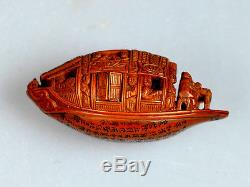
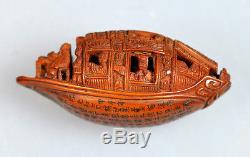


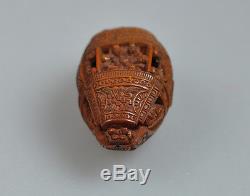

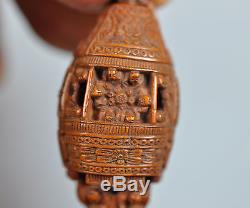
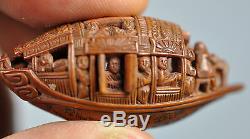
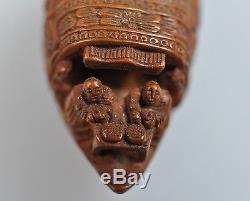

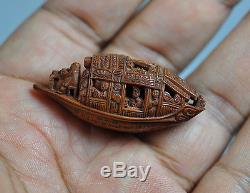
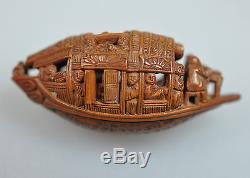


An antique Chinese Olive nut or kernel carving of a boat with ca. 26 passengers, engraved with a poem by Su Dongpo, ca 120 characters, on the base. Dimensions: 43 x 20 mm. Very good condition as shown. At Chibi (The Red Cliffs), t.
He poet Su Shi (Dongpo) and his companion are sitting and drinking in the front of the boat, with 2 servants standing behind them. Both sides of the cabin are carved with windows, one of them has shutters which can be opened and closed easily.
There are 26 people on the boat; 6 of them are watching the full moon. The Chinese poem written on the base of the boat is. In the autumn of 1082, on the 16th of the seventh month, I, Su, and my guests sailed in a boat below the Red Cliffs. Clear wind blew gently, the water was calm. The boaters raised their wine and poured for each other, reciting "The Bright Moon" and singing The Lovely One. After a while, the moon rose above the eastern mountain, and hovered between the Dipper and the Cowherd star. White mist lay across the water; the light from the water reached the sky. They went where their tiny boat took them, floating on a thousand leagues of haze, in the vastness as if resting on emptiness and riding the wind, not knowing where they would stop, floating as if they had left the earth and stood alone, having turned into birds and become immortal. And so they drank and their joy reached its height, and they sang beating on the side of the boat. Cassia oars and orchid paddles Beat the illusory moon, Rowing against the flow of streaming light. From a great distance my heart Yearns for my beloved at one end of the sky. Su Shi (January 8, 1037 August 24, 1101), also known as Su Dongpo, was a Chinese writer, poet, painter, calligrapher, pharmacologist, gastronome, and a statesman of the Song Dynasty. Nut carving, known as Hediao in Chinese, generally refers to two kinds of carvings that respectively use fruit stone (also known as the fruit's pit). Like olive or peach stone, and walnut as the raw material. The art form is acclaimed for its delicate carving skills on the small fruit stones or walnuts, and is known as an "uncanny work of art" among the people.Nut carving generally uses relief and three-dimensional carving skills due to the materials' limited surface area. To produce a fine piece of nut carving, one has to make good use of the shape, grains. And texture of the material; a blueprint also has to be made before the actual carving can begin.
The art form had already attained very high achievements, with many of the rich and high officials considered it fashionable to wear a piece of nut carving around. The ancient artists left their consummate skills on those small works, which featured human figures, various utensils, and some even with lines of poems.
Such legacies inspired many ancient literati to record them with passages, with one of them known as Nut Carving Boat. Which has been included in Chinese middle school textbooks. Many people came to know the art form beginning from this passage, which describes the nut carving work by Wang Shuyuan in the Ming Dynasty. The work, carved on a peach stone, features the scene of Su Dongpo (an influential poet and essayist of the Song Dynasty) going boating at night in Chibi in Central China's Hubei Province.
This beautiful antique artefact is from. The item "FRUIT PIT CARVING BOAT POEM HEDIAO SU DONGPO CHINESE CHIBI QING CHINA 19TH C" is in sale since Sunday, September 07, 2014. This item is in the category "Antiques\Asian Antiques\China\Other Chinese Antiques". The seller is "eternality" and is located in Scania. This item can be shipped worldwide.
- Type: Carving
- Primary Material: Olive kernel
- Age: 1850-1899
- Region of Origin: China
- Original/Reproduction: Original

